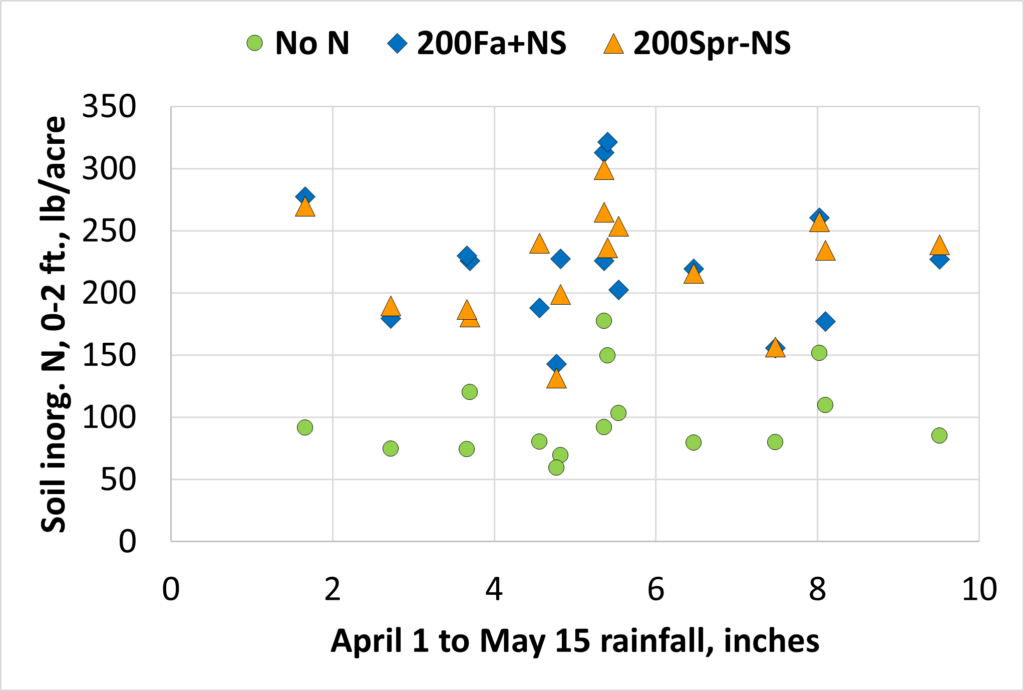Wet Spring Weather and Nitrogen Loss Revisited
You can also read this article in Portuguese and Spanish
April temperatures were warmer than normal in Illinois, making the January-April period one of the warmest on record. April was also wetter than normal, and as rains have continued into May, questions about nitrogen (N) losses continue to increase. This concern is greater for fall-applied N, but warm soil temperatures and wet soils have some people talking about the possible need for more N to replace what might have been lost so far.
As we discussed in our last article, relatively dry weather from last fall through March limited tile drainage flow, so N loss over the colder months was minimal. April rainfall was above normal over nearly all of Illinois, and it was 50 to 100 percent above normal through the central part of the state. Tile flows have increased accordingly, and nitrates in public water supplies have increased, but remain below critical thresholds.
Although wet spring weather always brings concerns about N loss, meaningful estimates of how N loss might affect yield, and whether additional N will be needed, are little more than guesses this early in the season. Tile N loss measurements tell us how much N has left the field, but because a lot of the crop’s N supply comes from the mineralization of soil organic N, how much N has left the field tells us little about the season-long N supply for the crop.
In a 2-year study at the Dudley Smith Farm in Christian County, we found that plots with 120 lb N applied as fall anhydrous ammonia with N-Serve lost an average of 15.4 lb nitrate-N per acre through tile lines between October and April, while plots with no fall N lost 9.3 lb N. While it is reasonable to assume that some N applied last fall has been lost through tile drainage, most previous studies show modest losses of N, even when spring weather is wet. Another 4-yr (2016-2019) study in central Illinois reported annual (not just winter) nitrate losses ranging from 20 to 56 lb N/acre following the application of 160-180 lb N as NH3 + N-Serve in the fall. The 56-lb loss was in 2019, the year with very high spring rainfall and much-delayed planting.
We reported in our earlier article results from a 4-year study at four Illinois sites showing that fall and winter conditions had little effect on how much soil N was in the spring, and that similar amounts of N were recovered from fall- and spring-applied ammonia. We went back and looked in more detail at spring rainfall at each site to see if rainfall amounts affected how much N was in the soil in mid-May to early June, as the crop began to grow. Figure 1 shows that rainfall varied widely, from less than 2 inches to more than 9 inches, between April 1 and May 15. However, the amount of rainfall had no influence on the amount of soil N recovered, regardless of whether N was applied in the fall or in the spring. Averaged across sites, we recovered 100 lb of plant-available N (nitrate + ammonium) in plots without fertilizer N, 223 lb N from plots with fall-applied N, and 222 lb N from plots with early spring-applied N.

Should we apply additional nitrogen?
Although there is legitimate concern about how much N will be available to the 2024 corn crop once it becomes established in the field, the only thing that we can say with conviction is that mid-May is not the time to decide that we will need to increase rates of applied N this spring. In the study mentioned above, only 1 bushel separated yields from fall- versus spring-applied ammonia, and the amount of N recovered from the soil during early growth was unrelated to yield. We may find off-color corn in fields planted in early April, but it doesn’t necessarily mean a lack of N, as light-green corn can also be a response to very wet conditions (slowed root activity and growth). Assessing whether the stand has been damaged, the potential for plant recovery, the possibility of replanting, and other factors affecting yield potential are also crucial at this point.
If now is not the time to decide, then when do we decide whether to add more N? Yield potential and N requirements will be determined by growing conditions during the season, and both crop growth and the rate of mineralization of soil-supplied N will be favored if soils return to normal moisture levels, and if temperatures remain warm. Delayed planting into warm soils will increase the amount of soil-supplied N to help get the crop off to a fast start. But if soil conditions remain (or return to) wet, restricted root growth and function could limit both crop growth and access to soil N. This makes the decision about adding additional N a complicated one, but if the crop gets off to a good start with good color by early June, it may well reach its yield potential without adding to a normal rate of N (170 to 200 lb of N/acre) applied early. Those who experienced the very wet June of 2015 may recall that, although many trials showed that higher N rates increased yields, this was in most cases not because a lot of N was lost, but because roots in saturated soils were not able to take up and utilize the N that was present.





